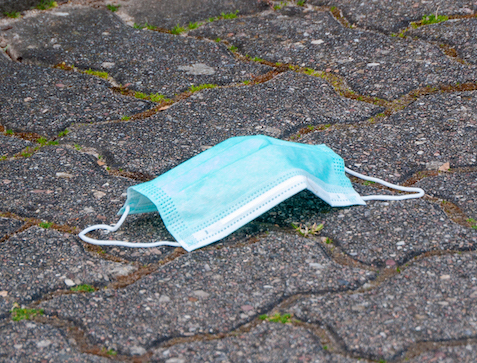Esme Symons, Technology & Engineering editor
They are appearing everywhere like dandelions in spring: disposable masks. But while dandelions are a natural phenomenon that heralds warmer weather, disposable masks on the sidewalk or in the street are just garbage.
Uptick in disposable mask usage

Worldwide, people discard an estimated 1.6 million tonnes of PPE every day. Photo by Matti Blume 2020 CC BY SA 2.0
Disposable mask usage has increased dramatically due to the COVID-19 pandemic. Personal protective equipment (PPE) is being used not only by healthcare professionals but also by the general public. Projections made by Health Canada in June 2020 estimated that 63,000 tons of PPE would be used and discarded by Canadians over the next 12 months. Worldwide, people discard an estimated 1.6 million tonnes of PPE every day.
Disposable masks are made of plastic, specifically, polypropylene, which has wide-ranging applications, from plastic bottles to diapers, upholstery, and outdoor furniture. If these masks are not disposed of properly, they may end up in the oceans, where, like plastic bags, they cause massive problems for marine ecosystems. Sea creatures may accidentally ingest discarded PPE. Plastic masks may also release microplastics and chemicals as it slowly degrades, causing illnesses in some animals. There is also a concern that larger animals can become trapped in the ear loops.
The two most common ways of disposing of these masks are incineration or putting them in a landfill. Both damage the environment.
Although plastic pollution isn’t new, the volume of disposable masks is. Researchers across Canada are taking different approaches to tackle this problem.
Plastic mask recycling
Recycling may be the answer to managing the polypropylene masks already in production and use. Municipal recycling programs cannot currently recycle PPE. That doesn’t mean it’s impossible to recover the material from the disposable masks.
A pilot project in the Vancouver, B.C., area is collecting masks from healthcare centres for specialized recycling. The program started in February 2021 and is a collaboration between McMaster University researchers and Vitacore, a Burnaby-based mask and respirator manufacturer. This project is the first recycling initiative for single-use masks and respirators in Canada. The collected equipment is taken to a B.C. facility to be heat sterilized before being shipped to the researchers in Hamilton, ON. The masks are melted into polypropylene pellets, which can be used to reinforce concrete or other composites, or exploited for their insulation properties. McMaster University’s Centre of Excellence in Protective Equipment and Materials researchers continue to find optimal ways of processing and using the polypropylene pellets. One major challenge is that the solution needs to be more cost-effective than using virgin material to be widely adopted.
Using paper instead of plastic
Although it is possible to create biodegradable plastics for masks, another approach to this problem is removing the plastic in masks altogether. The BioProducts Institute at the University of British Columbia is looking into making masks out of plant-based materials. The idea is to create a cellular material by extracting cellulose fibres from wood or other plants. This cellular material is breathable but has good filtration properties that are comparable to a polypropylene mask. Cellular materials have a network of holes within them, like a sponge. This configuration allows the mask to have the proper filtration properties.
This cellular material’s other important property comes from being wood-based. The material is similar to paper and can be recycled more easily than plastic. If the discarded masks don’t make it to the recycling facility and become litter, they can safely decompose without harming the surrounding environment. The University of British Columbia will be working with industry partners to get these masks into production.

In lower-risk situations and combined with other measures, cloth masks can be a good solution. Photo by Filo gèn’ on Wikimedia, CC-BY-SA 4.0
Washable fabric masks
Although not suitable for a hospital setting, reusable fabric masks do offer some protection, blocking approximately 60 per cent of airborne particles. In lower-risk situations, and combined with other measures including physical distancing, cloth masks can be a good solution. Some fabric masks have pockets to hold a disposable filter, which improves the filtration while keeping most of the mask reusable.
Reusable fabric masks. Image credit: Filo gèn’ on Wikimedia (CC-BY-SA 4.0)
What can we do right now?
While we wait for these innovations to become available, we should dispose of our plastic masks correctly. Cut through the ear loops and put them in the garbage. In low-risk situations, it may be feasible to reuse a disposable mask. You might also consider wearing a washable cloth mask. Finally, remember to practise social distancing.
~30~



